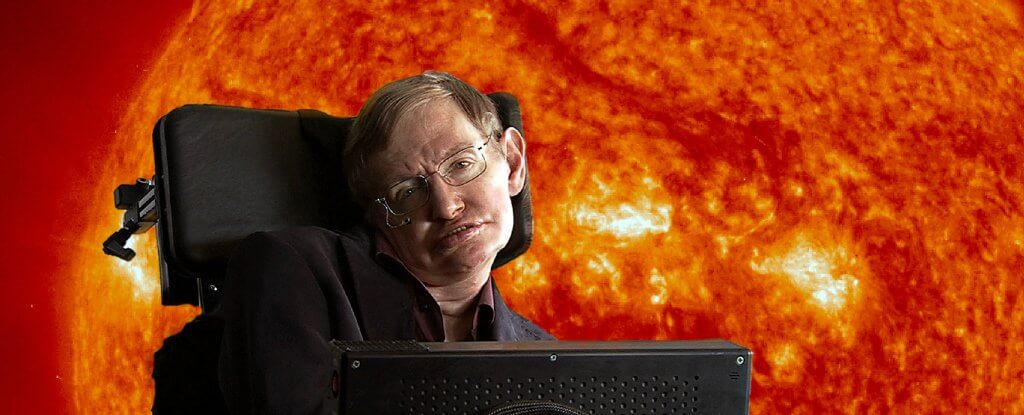- Get link
- X
- Other Apps

Before the outstanding modern physicist Stephen Hawking left this world, he managed to abandon his last scientific work - his latest theory of the nature of the universe, which he co-wrote with his Belgian counterpart Thomas Hertog from the Catholic University of Leuven. The work was finally published in a scientific journal , and more in detail with it it is possible to familiarize .
Thomas Hertog, who co-wrote the work with Hawking, said that their goal was "to turn the idea of the multiverse into an auditable scientific basis." And the material published in the Journal of High Energy Physics says that the universe is much less complex than modern theories of the multiverse suggest.
The work is based around the concept of infinite inflation of the universe, first introduced in 1979 and published in 1981.
After the Big Bang, the universe experienced a period of exponential inflation (rapid expansion). Then this expansion slowed, and the energy of the universe passed into matter and cosmic radiation. However, according to the theory of infinite inflation, in the universe there were bubbles of space that completely ceased to expand or headed for a complete stop of this expansion, thus forming fractal dead ends of static space. At the same time, in other spatial bubbles, due to quantum effects, inflation did not stop, which in turn led to the formation of an infinite number of multiverse. According to the theory, everything that we see inside the universe we observe is enclosed in only one of these bubbles. In it, inflation stopped, which allowed the emergence of stars and galaxies.

Visualization of an expanding multiverse
"The familiar theory of infinite inflation predicts that on a general scale our universe is like an endless fractal, with a mosaic of various pocket universes separated by an expanding ocean," explains Hawking.
"Local laws of physics and chemistry can differ from one pocket universe to another, which together form a multiverse. However, I was never a fan of the multiverse theory. If the scale of the different universes within the multiverse is too huge or even infinite, then the theory will be impossible to verify. "
In recent years, the model of infinite inflation of the universe has been seriously criticized. For example, Paul Steinhardt, a physicist at Princeton University, made a statement that initially a theory that took on the task of universally explaining all that we observe in the universe simply changed the model.
In a new paper, Hawking and Hertog say that the model of infinite inflation is incorrect, since the laws of the General Theory of Relativity of Einstein break up at the quantum level, becoming useless.
"The problem with the usual model of infinite inflation is related to the fact that it presupposes the existence of a background universe that evolves in accordance with the General Theory of Relativity of Einstein and considers quantum effects only as minor fluctuations," explains Hertog.
"However, the dynamics of endless inflation erases the division between classical and quantum physics. As a consequence, Einstein's theory breaks down in infinite inflation. "
The new theory takes the string theory - one of the models that tries to link the General Theory of Relativity to quantum theory, replacing the tiniest particles from particle physics with tiny oscillating one-dimensional strings.
According to the holographic principle in string theory, the volume of space can be described by its boundaries. In other words, in a sense our Universe is like a hologram in which a physically real three-dimensional space can be mathematically reduced to a 2D projection on its surface.
Scientists have proposed a variation of the holographic principle, which projects a time dimension in infinite inflation, which allows us to describe a general concept without having to rely on the General Theory of Relativity. This in turn allowed researchers to mathematically reduce endless inflation to an infinite state on the spatial surface from the beginning of the universe - the hologram of infinite inflation.
"When we tracked the evolution of our universe back in time, at some point we reached the threshold of infinite inflation, where our familiar concept of time ceases to matter," Hertog notes.
In 1983, Hawking, along with physicist James Hartl, proposed the concept of an unlimited theory of the universe. In it, scientists said that at the time of the Big Bang in the universe there was only space, but there was no time and no boundaries. The concept of Hawking and Hartle allowed the existence of parallel worlds, for which a single wave function is defined. In this diversity of universes, the reality observed by man is only one of the possible.
According to the new theory, the early universe had boundaries, and this allowed Hawking and Hertog to get more reliable predictions of its structure.
"We predict that our universe on a general scale is fairly smooth and has boundaries. It does not represent a fractal structure, "Hawking said.
The findings of this work do not contradict the idea of multiverse, but they reduce them to a much smaller range. In other words, the theory of the multiverse in the future can be verified if, of course, the conclusions of Hawking and Hertog succeed in repeating and confirming by other physicists.
Hertog himself would like to test his conclusions with Hawking through observations of gravitational waves that could be created by endless inflation. These waves are too huge for them to be identified with the LIGO interferometer, but future gravitational wave interferometers, such as terrestrial LISA, and subsequent observations of background cosmic radiation, could identify them, the researcher believes.
The article is based on materials .
- Get link
- X
- Other Apps
Comments
Post a Comment